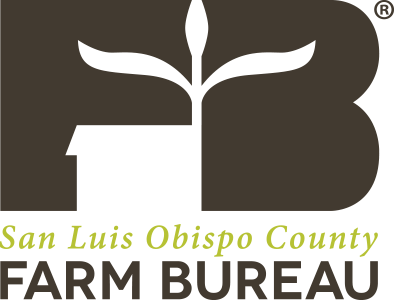.png)
Federal assistance is available to SLO County farmers, ranchers and agriculture businesses who suffered damages from Winter 2023 storms. Details are described below. While SLO County Farm Bureau does not administer disaster relief programs, we are here to help! Please contact our office if we can answer any questions at 805-543-3654 or email info@slofarmbureau.org
FOR THE LATEST INFORMATION, READ OUR LATEST WEEKLY EMAIL NEWSLETTER (EVERY MONDAY) BY CLICKING HERE.
Update May 22, 2023:
Damages from storms in February in March 2023 are now eligible for disatster assistance programs. Previously, only January storm damages were eligible, but an amendment was made to Presidential Major Disaster Declaration FEMA-4699-DR as a result of the Severe Winter Storms, Straight-line Winds, Flooding, Landslides, and Mudslides that occurred beginning February 21, 2023, and continuing. For more information, contact San Luis Obispo County USDA FSA Service Center in Templeton at 805-434-0396 ext. 2. The deadline to apply for Emergency farm loans for both physical and crop production losses as a direct result of the disaster is December 14, 2023. Other USDA programs may have different deadlines; do not wait to reach out to USDA.
Update April 14, 2023:
The deadline to apply for USDA Farm Service Agency's Emergency Conservation Program has been EXTENDED to October 14, 2023. Read the announcement here.
Update February 27, 2023:
Applying for federal disaster assistance has been a confusing and frustrating process for SLO County agriculture. Last week, at our Agriculture Storm Briefing with Congressman Panetta we received additional clarity. San Luis Obispo County Farm Bureau is here to help. Whether you are a Farm Bureau member or not, you can contact our office for information at 805-543-3654 or info@slofarmbureau.org. Here’s what we know today:
Small Business Administration and FEMA Assistance
Farmers and ranchers that raise an agricultural commodity (e.g. cattle, lettuce, winegrapes) are NOT eligible for U.S. Small Business Administration (SBA) disaster assistance for their business losses. Damages to personal (not business) property like a residence ARE eligible for SBA loans or Federal Emergency Management Agency (FEMA) grants.
Agriculture-related businesses like a winery, irrigation company, or any other business that does not grow a commodity ARE eligible for SBA assistance. If your business produces a commodity, but also has other non-production operations, you might be eligible for SBA assistance. For example, a business that grows winegrapes and also makes wine might qualify for SBA assistance for the winery operation damages, even though damages to the farming operation are not covered.
- The eligibility determination for an agricultural entity that also has a non-agricultural component is made by the SBA loan officer after reviewing the financial information of the entity. “Under § 7(b) of the Small Business Act, SBA may not provide disaster loans to agricultural enterprises.A business may be primarily an agricultural enterprise but also have a non-agricultural, separable component. The non- agricultural venture may be eligible for a business physical disaster loan regardless of the "primary" activity of the overall business structure or affiliated group. To be eligible, the non-agricultural venture must be a separable operation and not just part of the agricultural enterprise, with separable and distinguishable income, operations, expenses, assets, etc.”
The deadline to apply for SBA and FEMA is March 16, 2023. Apply online for SBA loans at or in person at the SBA Disaster Loan Outreach Center (DLOC) in San Luis Obispo. FEMA staff will also be onsite to assist residents in applying for FEMA disaster assistance in-person and follow up on existing applications. The Disaster Loan Outreach Center is located at the San Luis Obispo Library - 995 Palm Street, SLO, and is open Tuesdays-Wednesdays from 10am-6pm, Thursdays-Fridays from 10am-5pm and Saturdays from9am-2pm.
- See the SBA Fact Sheet for interest rates and details. FEMA grants may pay for temporary housing, emergency home repairs for the primary residence, uninsured and underinsured personal property losses and medical, dental and funeral expenses caused by the disaster, along with other serious disaster-related expenses.
- FEMA may also be able to cover damages to privately-maintained roads and bridges. If multiple residents rely on the road or bridge, the neighborhood may need to coordinate their application to FEMA.
USDA Farm Service Agency Assistance
Farmers and ranchers should apply to the USDA Farm Service Agency for both cost share programs (grants) and low-interest loans. If you had damages from the flood, do not wait any longer to contact FSA. San Luis Obispo County USDA FSA Service Center in Templeton at 805-434-0396 ext. 2
One of the main programs of interest has been the Emergency Conservation Program. This is a cost-share program that may cover expenses like debris removal, restoring eroded fields, and installing fences. The application deadline for the Emergency Conservation Program is April 14, 2023 has been extended to October 14, 2023 (read the announcement here).
- NEW INFORMATION: If you have already contacted FSA about damages and are awaiting a site inspection before you can began work (as is usually required by the program), there is a chance you can be approved to begin work before your Emergency Conservation Program application is approved. If you consider it an emergency and cannot wait for an inspection, you should submit a written request to FSA attesting that “Getting this work done is an emergency and needs to begin immediately.”
- SLO County FSA has already began conducting site inspections for the more than 300 applications received. The timeline to complete all the inspections is not certain, but 3-4 weeks is FSA’s goal. If you cannot wait, it is worth making this request to FSA.
FSA’s Emergency Loan Program is now open and applications are due September 18, 2023 for San Luis Obispo County. This low-interest loan program (current rate is 3.75%) finances up to $500,000 in storm-related business damages and losses. Emergency loan funds may be used to:
- Restore or replace essential property
- Pay all or part of production costs associated with the disaster year
- Pay essential family living expenses
- Reorganize the family farming operation
- Refinance certain non-real estate operating debts
You can apply through the FSA office in Templeton, but the FSA office in Santa Maria administers the loan program for San Luis Obispo County. For questions about the Emergency Loan Program contact Gary Troester, FSA Farm Loan Manager for Santa Barbara/Ventura/San Luis Obispo Counties at 805-928-9269 x2 or gary.troester@usda.gov
See a list of other FSA cost share or grant programs like the Tree Assistance Program (covers crops like citrus and winegrapes), Livestock Forage Disaster Program (grazing losses), and Emergency Assistance for Livestock, Honeybees, and Farm-Raised Fish (livestock losses) here. Other FSA programs may have different application deadlines.
Update February 23, 2023: Congressman Jimmy Panetta, SLO County Farm Bureau Hold ‘Agriculture Storm Briefing’ Feb. 23 - Farmers, Ranchers, Agriculture Businesses Who Experienced Storm Damage Encouraged to Attend
All farmers, ranchers, agriculture businesses and the public are invited to an Agriculture Storm Briefing hosted by Congressman Jimmy Panetta on Thursday, February 23 at 5:30pm at The Carlton located at 6005 El Camino Real, Atascadero. Learn more here.
SLO County Disaster Resource Center - Starting January 24, SLO County has a Disaster Recovery/Local Assistance Center open seven days a week, from 8:00 AM to 7:00 PM at the Veterans Memorial Building, 801 Grand Ave in San Luis Obispo. The center is expected to be open at least 2 weeks. More info here. (UPDATE: The SLO County Disaster Resource Center is now closed as of February 14, 203.)
· Step 1: Contact the USDA Farm Service Agency office in Templeton at 805-434-0396
· Step 2: Report Agricultural Damage Estimates to the County of San Luis Obispo for FEMA
· Step 3: Report Property Damages (non-agricultural) to the County of San Luis Obispo for FEMA
Step 1: Contact the USDA Farm Service Agency office in Templeton
The first step farmers and ranchers in SLO County should take is to call the USDA Farm Service Agency office in Templeton at 805-434-0396. Note that some FSA staff have been unable to travel to the office due to storm damage, so calling may be preferable to coming in-person to the office. FSA will ask for your name, mailing address, phone number and email address. FSA staff will send the disaster application information and fact sheets with program information. Information on applicable programs are summarized below, and you can access background information on USDA Disaster Programs at farmers.gov/recover
Emergency Conservation Program (ECP)
The Emergency Conservation Program (ECP) provides funding for farmers and ranchers to rehabilitate farmland, replace or repair fences damaged by natural disasters and to carry out emergency water conservation measures during periods of severe drought. Our local FSA staff in Templeton also provided the following guidance:
· Farmers and ranchers are advised to take a lot of pictures of all damages when it is safe to do so. Examples include mudslides, debris in cropland and grazing land, erosion, and damage to access roads, fencing, corrals, barns, etc. These pictures should be submitted with your application to FSA.
· This Emergency Conservation Program is for Cropland including vineyards, orchards, hay, grain, vegetables and other row crops, and grazing land.
· Farms of all sizes should apply. The Adjusted Gross Income cap of $900,000 does not apply for ECP program. This means if your AGI is over $900,000.00 you are eligible to apply for the program.
Emergency Assistance for Livestock, Honeybees, and Farm-Raised Fish (ELAP)
The Emergency Assistance for Livestock, Honeybees, and Farm-raised Fish Program (ELAP) provides financial assistance to eligible producers for livestock, honeybee, and farm-raised fish losses – such as death, feed, grazing, and associated transportation costs – due to disease and certain adverse weather events or loss conditions. The program addresses losses not covered by other USDA disaster assistance programs. Our local FSA staff in Templeton also said that if your hay or other feed was damaged by water take pictures of the damage when safe to do so.
Livestock Indemnity Program (LIP)
The Livestock Indemnity Program (LIP) provides benefits to livestock owners and contract growers who experience livestock deaths in excess of normal mortality caused by specific adverse weather, disease, or animal attacks. Our local FSA staff in Templeton also provided the following guidance:
· Take photos of livestock deaths when it is safe to do so.
· Eligible livestock must: (1) Have been maintained for commercial use as part of a farming operation on the day they died; and (2) Not have been produced or maintained for reasons other than commercial use as part of a farming operation. Excluded livestock includes wild free-roaming animals, pets or animals used for recreational purposes, such as hunting, roping or for show.
The Tree Assistance Program (TAP) provides financial assistance to eligible orchardists and nursery tree growers to replant or rehabilitate eligible trees, bushes, and vines lost by natural disasters. TAP is administered by the Farm Service Agency (FSA) of the U.S. Department of Agriculture (USDA). To qualify for TAP, eligible orchardists and nursery tree growers must:
- Have suffered a qualifying tree, bush or vine loss in excess of 15 percent mortality for the stand (adjusted for normal mortality) due to an eligible natural disaster;
- Have owned the eligible trees, bushes and vines when the natural disaster occurred, but eligible growers are not required to own the land on which owned eligible trees, bushes and vines are planted; and
- Replace eligible trees, bushes and vines within 12 months from the date the TAP application is approved.
Step 2: Report Agricultural Damage Estimates to the County of San Luis Obispo for FEMA
On Sunday, January 15, the County of San Luis Obispo working with the County Department of Agriculture / Weights & Measures released an agriculture-specific FEMA damage estimate form online. Find it here. By completing this form you are helping SLO County qualify for a USDA disaster declaration and possible subsequent aid. If you need assistance completing this form, call the County Agriculture Department at 805-781-5910.
Step 3: Report Property Damages (non-agricultural) to the County of San Luis Obispo for FEMA
In addition to reporting agriculture damages, all property owners are being asked by the County of San Luis Obispo to report damages on RecoverSLO.org (direct link to the form is here)
Other Resources and Information:
On Tuesday, January 24 at 12:00 PM, a Disaster Recovery Center (DRC) and Local Assistance Center (LAC) will open in San Luis Obispo to provide resources to residents who were affected by the storms. The DRC/LAC is a partnership between the Federal Emergency Management Agency (FEMA), Governor’s Office of Emergency Services (Cal OES), and County of San Luis Obispo.
The DRC/LAC will be open seven days a week, from 8:00 AM to 7:00 PM at the Veterans Memorial Building, 801 Grand Ave in San Luis Obispo. Residents can get help applying for federal assistance and disaster loans, update applications, and learn about other resources that are available. Spanish and ASL interpreter services will be present. If you need transportation to the DRC/LAC, please call the County Office of Emergency Services at (805) 781-5678. More details here.
· Evacuation Orders: Find the latest evacuation area information here.
· Road Closures: A significant number of local roads remain closed. Find the latest list here. The County reported a number of incidents where drivers have become stranded, suffered significant damage to their vehicles, and impeded disaster response activity by ignoring road closure signs. Even when no standing water is present, roads designated as closed may be at risk of collapse.
· Volunteer to Help: In addition to the ongoing hard work of our first responders and County staff, we’ve seen neighbors helping neighbors across SLO County. If you are interested in volunteering with relief efforts signup here.
· Donate: The Community Foundation of San Luis Obispo County has activated a Disaster Support Fund in response to recent storms, floods, and earthquakes in California. 100% of contributions will support efforts to respond to the disasters. Donate here.
· Community Alliance of Family Farmers has a statewide California Family Farmer Emergency Fund that is accepting contributions. More information online here or contact CAFF staff Amber Schat at amber@caff.org
· California Department of Food and Agriculture - Flood Recovery Resources for Agriculture https://www.cdfa.ca.gov/FloodRecovery/
· USDA Rural Development - Grants for home repairs



